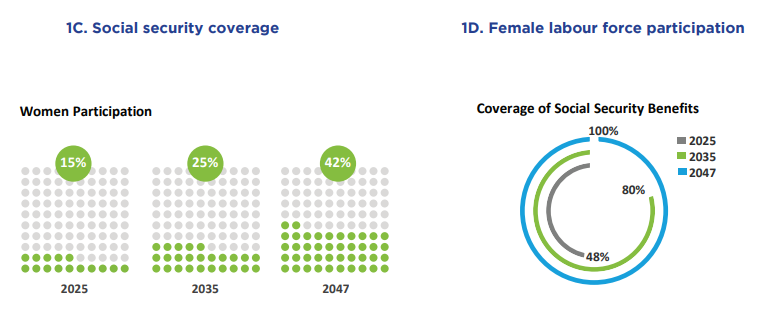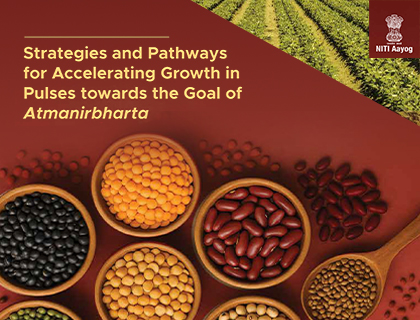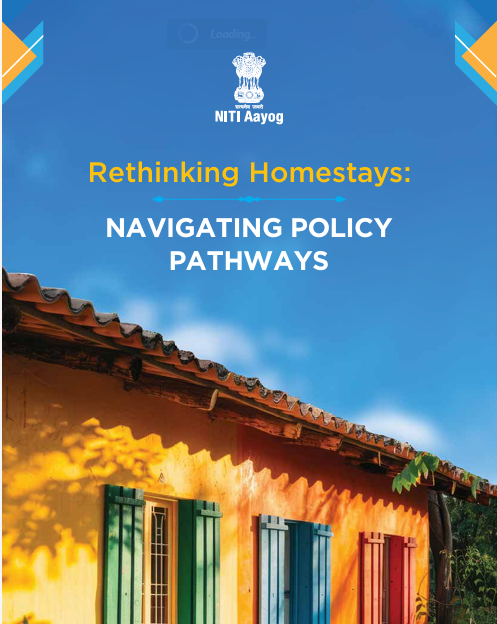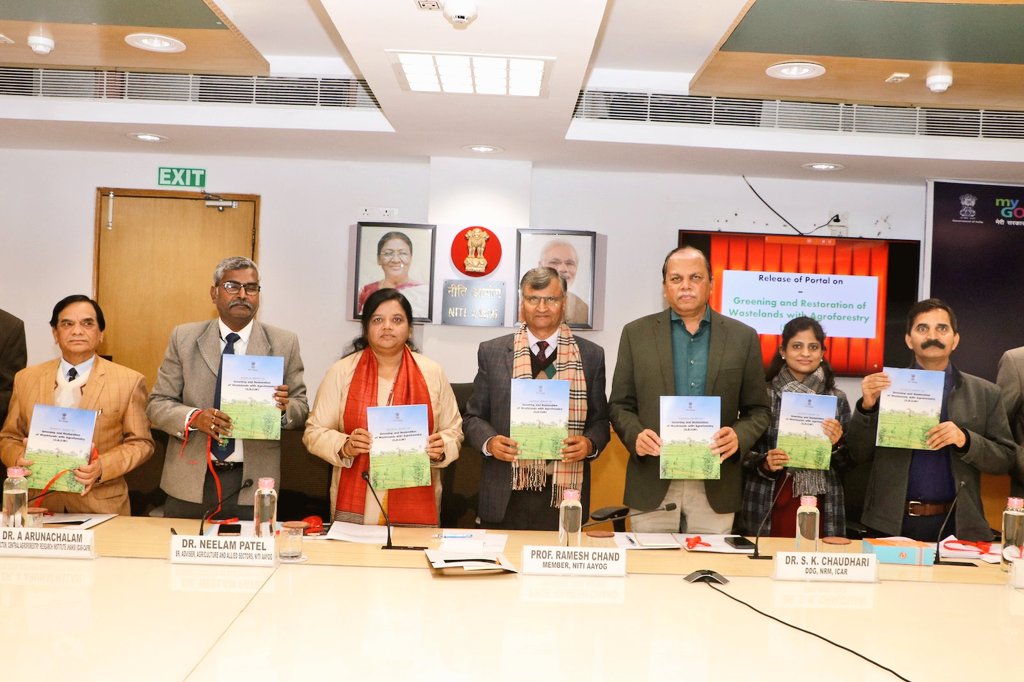NITI Aayog report “Roadmap on AI for Inclusive Societal Development”

- 11 Oct 2025
In News:
NITI Aayog has unveiled its strategic report “Roadmap on AI for Inclusive Societal Development”, which presents a comprehensive vision for leveraging Artificial Intelligence (AI) to strengthen India’s vast informal economy through enhanced digital inclusion, skilling, and social protection systems.
Status of India’s Informal Workforce
- Scale and Economic Role: Approximately 490 million Indians—about 90% of the national workforce—are engaged in informal employment spanning agriculture, construction, and services, together contributing nearly half of India’s GDP (MoLE, 2024).
- Rural Dominance: Over 80% of rural labourers operate without written contracts or social security coverage, especially in construction, handicrafts, and retail sectors.
- Gendered Vulnerability: Women constitute around 55% of the informal workforce, with significant representation in home-based and agricultural activities (ILO, 2023).
- Low Productivity and Earnings: Informal sector productivity remains roughly one-fourth that of the formal economy, perpetuating low wages and economic insecurity.
- Emergence of Urban Informality: The gig and platform economy has created a new informal class, with nearly 7.5 million platform workers (NITI Aayog, 2022) still outside formal labour protections.
Core Challenges
- Financial Instability: Over three-fourths of informal workers earn below ?10,000 per month and face limited access to affordable credit or insurance (PLFS, 2024).
- Market Inefficiencies: Only about 12% of small producers or artisans access digital or organized markets directly, remaining dependent on intermediaries.
- Digital and Skill Divide: Around 70% of informal workers lack basic digital literacy, impeding their participation in AI-integrated economies.
- Weak Social Protection: Just one-third of eligible informal workers are registered under welfare schemes such as e-Shram or PM-SYM.
- Policy Fragmentation: Overlapping databases and weak institutional coordination hinder effective benefit delivery and erode worker trust.
Transformative Potential of AI
- Financial Empowerment: AI-based credit assessment tools (e.g., SBI YONO, Setu.ai) can facilitate microloans for workers lacking traditional financial records.
- Digital Public Infrastructure (DPI): Platforms such as Aadhaar, UPI, and e-Shram can establish verifiable worker identities, improving transparency in wage payments and welfare targeting.
- Smart Contracts and Blockchain: Use of blockchain for wage traceability and supply chain verification (e.g., Tata Steel Foundation’s pilot in Jharkhand) can curb exploitation.
- AI-driven Skilling: Adaptive learning ecosystems like Skill India Digital can deliver personalized, voice-enabled vernacular micro-courses for re-skilling informal workers.
- Predictive Governance: AI-based data analytics can enhance targeting and timeliness of welfare delivery (e.g., integration with PM-Kisan data systems).
Major Recommendations
- Launch of ‘Digital ShramSetu Mission’: Create an AI-enabled national platform integrating social security, skilling, and livelihood databases for informal workers.
- Sector-specific AI Models: Focus on high-impact areas—agriculture, construction, logistics, and retail—for productivity enhancement.
- Inclusive Design: Develop voice-first, multilingual AI interfaces to ensure accessibility for low-literacy populations.
- Public–Private Collaboration: Promote partnerships among government agencies, startups, and tech firms for scalable innovation in informal ecosystems.
- Responsible AI Charter: Establish a framework ensuring transparency, privacy, and inclusivity in AI deployment for social sectors.
- AI-based Skilling Framework: Institutionalize micro-credential courses and continuous re-skilling under Skill India 2.0.
- Impact Evaluation Mechanism: Implement real-time data-driven monitoring to assess inclusion, income enhancement, and service delivery outcomes.
NITI Aayog’s Tax Policy Working Paper
- 06 Oct 2025
In News:
In October 2025, NITI Aayog released the first paper under the NITI Tax Policy Working Paper Series–I, titled “Enhancing Tax Certainty in Permanent Establishment and Profit Attribution for Foreign Investors in India.” The paper seeks to enhance transparency, predictability, and fairness in India’s international taxation framework—key to attracting and sustaining foreign investment in the journey towards Viksit Bharat@2047.
Background and Rationale
- Foreign Direct Investment (FDI) has been a cornerstone of India’s economic growth, rising from USD 6 billion in 2005–06 to nearly USD 50 billion in 2024–25. Despite this growth, foreign investors have long faced tax-related uncertainties—particularly concerning the definitions of Permanent Establishment (PE) and Profit Attribution. Ambiguities in these areas have led to prolonged litigation (often lasting 10–12 years), raising compliance costs and discouraging potential investors.
- To address these challenges, NITI Aayog’s Consultative Group on Tax Policy (CGTP)—comprising representatives from the CBDT, DPIIT, ICAI, industry experts, and major consultancy firms—developed this working paper through extensive stakeholder consultations.
Key Concepts
- Permanent Establishment (PE): Refers to a fixed place of business (like a branch, office, or digital presence) through which a foreign enterprise conducts business in India. If a PE exists, the enterprise is liable to pay tax on its income arising in India.
- Profit Attribution: Determines the portion of a multinational’s profits that can be taxed in India, particularly when business activities are spread across jurisdictions.
Major Recommendations
- Optional Presumptive Taxation Scheme:
- Allows foreign companies to opt for a fixed tax rate on India-sourced revenue, based on industry norms.
- Aims to minimize litigation and enhance predictability.
- Legislative Clarity:
- Codification of PE definitions and profit attribution rules in line with OECD and UN models.
- Avoidance of retrospective taxation and inclusion of due process safeguards.
- Strengthened Dispute Resolution:
- Expansion of Advance Pricing Agreements (APAs) and Mutual Agreement Procedures (MAPs).
- Exploration of mandatory arbitration for unresolved international tax disputes.
- Administrative and Institutional Efficiency:
- Introduction of safe harbour rules to simplify compliance.
- Adoption of the OECD’s TRACE system to streamline withholding tax relief.
- Continuous training of tax officials in complex cross-border taxation matters.
- Stakeholder Engagement and Transparency:
- Mandatory public consultations before major tax law amendments.
- Enforcement of a Taxpayer Charter to uphold fairness and transparency.
Judicial Context
The Supreme Court has played a pivotal role in interpreting India’s international tax framework:
- Formula One Case (2017): Held that even temporary use of infrastructure (like a race track) could constitute a PE, emphasizing substance over form.
- Hyatt International Case (2025): Clarified that even global losses do not exempt Indian operations from taxation, reinforcing the “separate enterprise” principle.
Alignment with Global Tax Reforms
India’s approach aligns with the OECD–G20 Base Erosion and Profit Shifting (BEPS) initiative, especially Action 7, which curbs tax avoidance through agency arrangements.
- Pillar One: Ensures digital giants like Google or Amazon pay taxes where consumers are located, even without a physical presence.
- Pillar Two: Introduces a global minimum corporate tax rate of 15%, deterring profit shifting to tax havens.
Significance:
The working paper provides a comprehensive framework for reforming India’s cross-border tax regime—balancing investor confidence with national revenue interests. By enhancing certainty, reducing litigation, and aligning with international standards, it aims to:
- Strengthen India’s Ease of Doing Business environment.
- Attract high-quality, sustainable FDI and FPI.
- Bolster administrative efficiency and taxpayer trust.
Ultimately, these reforms are expected to create afair, transparent, and globally competitive tax system, reinforcing India’s trajectory toward a future-ready economy and the vision of Viksit Bharat@2047.
India’s Path to Atmanirbharta in Millets

- 10 Sep 2025
In News:
The NITI Aayog report “Strategies and Pathways for Accelerating Growth in Pulses towards the Goal of Atmanirbharta” also provides broader lessons for achieving self-reliance in other food crops like millets, which face similar challenges of productivity, market stability, and sustainability.
Current Status of Millets in India
- Global Leadership: India contributes nearly 41% of world millet output (~16 million tonnes annually), making it the largest producer.
- Regional Spread: Five states—Rajasthan, Maharashtra, Karnataka, Uttar Pradesh, and Madhya Pradesh—produce over 80% of India’s millets.
- Consumption Decline: Per capita consumption has dropped from 32 kg/year in the 1960s to ~4 kg/year today, largely replaced by rice and wheat due to PDS bias.
- Exports: In 2022–23, India exported 1.8 million tonnes, mainly to UAE, Nepal, and Saudi Arabia, indicating rising global demand.
- Policy Push: The Union Budget 2023–24 renamed millets as “Shree Anna”, earmarking resources for research, processing, and marketing.
Importance of Millets
- Nutritional Security: Rich in iron, calcium, fiber, and proteins, helping fight malnutrition and anemia.
- Climate Resilience: Require 70% less water than rice and withstand drought, making them suitable for rainfed regions.
- Farmer Livelihoods: Low-input crops reduce reliance on irrigation and fertilizers, benefiting smallholders.
- Food Security: Inclusion in Mid-Day Meals, ICDS, and PDS enhances nutrition for vulnerable groups.
- Global Branding: India’s “Shree Anna” campaign has positioned millets as a superfood and strengthened agri-diplomacy.
Initiatives Taken
- NFSM-Millets: Expands area under millets, provides quality seed, and boosts productivity.
- Shree Anna Mission (2023): A six-year plan for millet research, processing, branding, and market integration.
- State Schemes: Karnataka’s Ksheera Bhagya included millets in school meals.
- International Recognition: India led the UNGA resolution declaring 2023 as International Year of Millets.
- Export Promotion: APEDA supports branding, GI tagging, and product exports to West Asia, US, and EU.
Challenges
- Consumer Preference Shift: Rice and wheat dominate diets due to PDS subsidies and cooking convenience.
- Low Productivity: Millet yields (~1.2 t/ha) remain below rice/wheat due to limited R&D and weak seed systems.
- Weak Market Linkages: Fragmented value chains, inadequate FPO presence, and absence of MSP-backed assured procurement.
- Post-Harvest Constraints: Poor processing/storage technologies and limited millet-based food industry.
- Policy Bias: NFSA subsidies for rice/wheat discourage millet adoption in rainfed belts.
Strategic Framework for Atmanirbharta
- Horizontal Expansion: Cultivate millets in rice fallows and degraded lands, especially in Eastern India.
- Vertical Expansion: Develop high-yielding, bio-fortified, climate-resilient varieties with robust seed systems.
- Cluster-Based Model: District-wise crop cluster strategy for focused interventions.
- Value Chain Integration: Establish processing hubs, branding centers, and FPO-led aggregation.
- Climate-Smart Farming: Promote organic and water-efficient millet practices, aligning with SDGs and climate goals.
NITI Aayog Report on “Rethinking Homestays: Navigating Policy Pathways”

- 28 Aug 2025
In News:
NITI Aayog, in collaboration with the Internet and Mobile Association of India (IAMAI), released the report “Rethinking Homestays: Navigating Policy Pathways”. The document provides a strategic roadmap for strengthening India’s homestay and BnB sector, emphasizing its role in tourism, rural livelihoods, and cultural preservation.
Key Highlights of the Report
- Tourism & Cultural Value: Homestays offer travelers culturally immersive experiences while promoting local entrepreneurship, heritage conservation, and community participation.
- Economic Role: They serve as engines of livelihood creation, particularly in rural and semi-urban areas, fostering inclusive and sustainable growth.
- Regulatory Approach: The report calls for light-touch, transparent regulation to balance safety, consumer trust, and ease of doing business.
- Digital Integration: Strong emphasis on leveraging digital platforms for marketing, consumer engagement, and capacity building of hosts.
- Public–Private Partnerships: Collaboration with stakeholders like Airbnb, MakeMyTrip, IAMAI, ISPP, Chase India, and The Convergence Foundation was highlighted as critical for shaping a vibrant ecosystem.
- Best Practices: State-level examples from Goa, Kerala, Uttarakhand, and Uttar Pradesh showcase scalable models in policy, governance, and community-led initiatives.
- Policy Recommendations: Suggests flexible frameworks, skill development, financial access, and infrastructure support to strengthen the sector.
Significance for India
- Tourism Development – Homestays diversify India’s hospitality sector, offering authentic alternatives to conventional hotels.
- Employment Generation – Potential to create entrepreneurial opportunities for women, youth, and local communities.
- Cultural Preservation – Encourages conservation of art, craft, cuisine, and heritage while generating income.
- Rural Transformation – Helps bridge urban–rural divides by promoting community-based tourism.
- Sustainability – Supports low-impact tourism models, aligning with SDG 8 (Decent Work & Economic Growth) and SDG 11 (Sustainable Cities & Communities).
About NITI Aayog
- Established: 1 January 2015, replacing the Planning Commission.
- Chairperson: Prime Minister of India.
- Vice-Chairperson: Appointed by PM.
- Members: Full-time, part-time experts, ex-officio Union Ministers.
- Governing Council: Chief Ministers of states and LGs of UTs.
- Functions:
- Premier policy think tank for cooperative federalism.
- Provides strategic and long-term policy frameworks.
- Monitors and evaluates development programmes.
- Promotes innovation, entrepreneurship, and technology adoption.
- Coordinates between Centre, States, and global partners.
- Nature: Advisory, yet influential in shaping policies; key driver of initiatives like Aspirational Districts Programme, Atal Innovation Mission, and SDG localization.
NITI Aayog Policy Report on Expanding Quality Higher Education
- 14 Feb 2025
In News:
NITI Aayog released a comprehensive policy report titled ‘Expanding Quality Higher Education through States and State Public Universities (SPUs)’, focusing on the development of higher education institutions, particularly public universities in India.
The report aims to enhance the quality, funding, governance, and employability outcomes within SPUs, which contribute to around 80% of the country's higher education system.
The document, the first of its kind in India, presents a detailed analysis of vital indicators like quality, funding, financing, governance, and employability over the last decade, supported by stakeholder consultations with over 20 states and Union Territories, Vice Chancellors, academicians, and State Higher Education Council Chairs. The report includes nearly 80 policy recommendations, along with 125 performance indicators, aiming to address long-standing challenges within SPUs.
Key Findings from the Report
- Funding:
- Maharashtra leads in funding for higher education, with Bihar and Tamil Nadu following closely behind.
- On the other hand, states like Sikkim, Arunachal Pradesh, and Nagaland have the lowest funding for higher education, highlighting regional disparities.
- University Density:
- The national average university density is 0.8 universities per lakh population. However, states such as Sikkim, with a density of 10.3, and Arunachal Pradesh, Ladakh, Meghalaya, and Uttarakhand have significantly higher densities. In contrast, states like Bihar, Uttar Pradesh, West Bengal, and Maharashtra have lower densities compared to the national average.
- Female Enrolment:
- Kerala, Chhattisgarh, and Himachal Pradesh have achieved higher female enrolment rates than males, which reflects positive gender inclusivity trends in certain regions.
- Challenges:
- Infrastructure deficits, including a lack of quality facilities and resources.
- A shortage of faculty and staff, particularly in advanced fields such as MTech and Ph.D. levels.
- Insufficient investment in research and development (R&D).
- Outdated courses, syllabi, and curricula, which are not aligned with industry needs.
- Financial constraints due to over-reliance on traditional revenue sources like admission fees and state grants.
- Administrative delays in fund sanctioning and the absence of frameworks for securing loans through financial institutions.
Policy Recommendations
The report proposes several reforms to address the aforementioned challenges, with a focus on improving educational quality, securing better funding, enhancing governance, and boosting employability:
- Funding and Investment:
- Increase the combined investment in education to 6% of GDP, as recommended in the National Education Policy (NEP) 2020.
- Increase R&D investment (both public and private) to 2% of GDP, as recommended in the Economic Survey 2017-18.
- Creating Centers of Excellence:
- SPUs should form clusters and focus on addressing local challenges by establishing Centres of Excellence. These centres should focus on region-specific issues to drive academic and practical advancements.
- Governance Reforms:
- Enhance governance structures at SPUs, empowering Vice Chancellors, faculty, and staff through targeted capacity-building initiatives.
- States may consider setting up dedicated finance agencies, similar to the Higher Education Financing Agency (HEFA), to fund infrastructure and research development specifically for SPUs.
- Financial Innovations:
- Develop financial frameworks to increase investment in education, ensuring access to timely funds, and reducing dependency on state grants or admission fees.
- Industry-Academia Collaboration:
- Strengthen the link between academia and industry to ensure that the curricula are relevant and prepare students for the job market. This can be achieved through increased partnerships, internships, and practical learning opportunities.
Greening India's Wastelands with Agroforestry (GROW) Report and Portal (DD News)

- 13 Feb 2024
Why is it in the News?
NITI Aayog recently unveiled the Greening and Restoration of Wasteland with Agroforestry (GROW) report and portal, aiming to bolster efforts in environmental conservation and sustainable land use across India.
About the Greening India's Wastelands with Agroforestry (GROW) Portal:
- The "Greening and Restoration of Wasteland with Agroforestry (GROW)-Suitability Mapping" portal offers universal access to state and district-level data.
- Hosted on the Bhuvan website, the GROW initiative aligns with national commitments to restore 26 million hectares of degraded land by 2030 and create an additional carbon sink of 2.5 to 3 billion tonnes of carbon dioxide equivalent.
- Led by NITI Aayog, the initiative involved collaboration from various institutions and utilized advanced technologies like remote sensing and GIS to assess agroforestry suitability across all Indian districts.
- Through thematic datasets, the project developed an Agroforestry Suitability Index (ASI) for national-level prioritization of greening and restoration projects.
- Based on analysis of five remote sensing-derived thematic layers - land use, wasteland, slope, water proximity, and soil organic content - the system provides information on areas suitable for agroforestry across India.
- It classifies areas as highly suitable, moderately suitable, and less suitable for agroforestry.
- Key features include generating district-level information on wasteland areas suitable for agroforestry, area prioritization regimes, live maps, area analysis-statistic reports, and an interactive mode/tool for flexibility in handling weights based on local conditions/needs.
Government Emphasis on Agroforestry in Budget Allocation:
- The Union Budget for the fiscal year 2022-23 has underscored the promotion of agroforestry and private forestry as a priority.
- Recognizing the critical goods and services provided by agroforestry, the budget aligns with the country's commitment to sustainable land use practices.
India's Agroforestry Leadership and Global Alignments:
- As the seventh-largest country globally, India faces challenges such as increased build-up areas, degraded land, and imbalanced resources.
- Approximately 16.96% of the Total Geographical Area (TGA) is a wasteland, necessitating transformation for productive use.
- India's pioneering National Agroforestry Policy, initiated in 2014, aims to enhance productivity, profitability, and sustainability through agroecological land use systems.
- Agroforestry aligns with global commitments, including the Paris Agreement, Bonn Challenge, UN Sustainable Development Goals, United Nations Convention on Combating Desertification (UNCCD), Doubling Farmers Income, Green India Mission, and more.
- India's proactive stance in promoting agroforestry contributes significantly to these international efforts, fostering a sustainable and resilient future.
Rapid Innovation and Startup Expansion (RISE) (Financial Express)

- 23 Nov 2023
Why is it in the News?
The AIM and NITI Aayog have recently introduced a new accelerator known as Rapid Innovation and Startup Expansion (RISE) aimed at providing support to startups in the circular economy sector in both Australia and India.
About Rapid Innovation and Startup Expansion (RISE):
- RISE, a collaborative initiative between Australia’s national science agency (CSIRO), and Atal Innovation Mission (AIM), the Government of India’s flagship initiative for fostering innovation and entrepreneurship, is a dedicated accelerator.
- This program is designed to support startups and small to mid-sized enterprises (SMEs) in India and Australia focusing on circular economy technologies and solutions.
Key Highlights:
- Focus Themes: The RISE Accelerator targets startups in India and Australia engaged in circular economy technologies, specifically in:
- Climate Smart Agriculture
- Clean Energy
- Circular Economy and Waste Management, and
- Climate Smart Mobility.
- Nine-Month Program: Over the course of nine months, the RISE Accelerator aims to assist startups in navigating early steps in a new region, establishing connections with the right partners, customers, and talent, and building credibility to succeed in international markets.
- First Round Focus: In its initial round, the accelerator concentrates on supporting startups and SMEs involved in technologies and solutions related to waste and the circular economy.
- Financial Support: Participating startups have the opportunity to receive up to INR 40,00,000 in non-equity grants.
- Future Rounds: Subsequent rounds of the accelerator will shift focus to climate-smart agriculture, clean energy, and climate-smart mobility.
